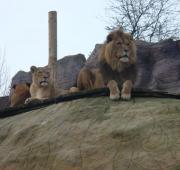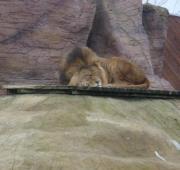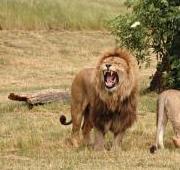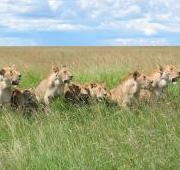 Lion Classification and Evolution
Lion Classification and EvolutionThe Lion is one of the largest, strongest and powerful felines in the world second only in size to the Siberian Tiger. They are the largest cats on the African continent and are unique among felines in a number of ways but the biggest difference between Lions and other cats is that they are incredibly sociable animals that live together in family groups known as prides. Lions are also part of the big cat family meaning that both males and females are able to roar. Despite having once roamed across much of Africa and even parts of Europe and Asia, the world's remaining Lion population now resides in sub-Saharan Africa. However, with Lion numbers thought to have dropped by 30% over the past 20 years these enormous predators are sadly becoming more and more vulnerable in their decreasing natural environment.
 Lion Anatomy and Appearance
Lion Anatomy and Appearance
Lions have a short coat of tawny or golden fur with a long tail that has a tuft of longer fur at the end. The markings on their coats are much fainter than the bold stripes and spots displayed on other felines which helps these large carnivores in going unseen when stalking prey in the long grasses. The Lion is one of the largest cats in the world with males being taller and heavier than females and displaying a mane of long hair around their faces (in fact, it is the only case in the feline world where males and females actually look different). Thought to be connected with testosterone levels, the mane of the male Lion ranges from blonde, to red, brown and black in color and covers their head, neck and chest. Lions have strong and powerful jaws that contain 30 teeth in total which includes four fang-like canines and four carnassial teeth that are perfectly designed for slicing through flesh.

Historically, Lions would have been found throughout much of Africa and even in parts of Europe and Asia as well. Today however, they have been pushed into more isolated pockets of their once vast natural range with the remaining African Lion population now only found in countries in sub-Saharan Africa. There is also still a small population of Asiatic Lions found inhabiting a remote part of the Gir Forest in India where there are an estimated 300 individuals remaining. Despite their dwindling numbers, Lions are actually incredibly adaptable animals that can and will inhabit very dry climates as they get most of the moisture they need from their food. They prefer areas of open woodland, scrub and long grasslands where there is not only plenty over cover but also a wide variety of prey. They are only not found in areas of rainforest or far into deserts.

Lions are unique among cats as they live together in strong social groups. A pride is made up of 5-15 related females and their cubs along with a generally single male (small groups of 2 or 3 though are not uncommon). Male Lions patrol a territory of around 100m² marking trees and rocks with urine and roaring to warn off intruders. Although male Lions can defend their pride to great effect, their position in the pride is constantly under threat from other males who try to take over their patch and if successful, they will kill any cubs that were sired by the previous male. Despite their enormous size, male Lions actually do hardly any of the hunting as they are often slower and more easily seen than their female counterparts. The Lionesses in the pride hunt together meaning that they are not only more successful on their trips, but they are also able to catch and kill animals that are both faster than them and much bigger.
Lion Reproduction and Life Cycles
Both male and female Lions are able to reproduce between the ages of two and three but despite this, they will often not breed until the pride has been firmly established. After a gestation period that lasts for nearly four months female Lions give birth to between one and six cubs that are born blind and are incredibly vulnerable in their new surroundings. The fur of Lion cubs is covered in darker spots that help to camouflage them into their den to protect them whilst the adults have gone out to hunt. Sadly however, less than half of cubs make it to be a year old and four out of five have died by the time they are two, generally either from animal attacks or starvation. Remarkably though, the female Lions in the pride will have their cubs at around the same time and will help to suckle and care for the cubs of other females. Lion cubs suckle on milk until they are about six months old and although they won't begin actively hunting until they are about a year old, Lion cubs start to eat meat after 12 weeks or so.
Lion Diet and Prey
The Lion is a large and carnivorous animal that survives only by eating other animals in order to sustain itself. Unlike other felines, Lions are not solitary hunters but instead the Lionesses work together in order to chase down and catch their prey with each female having a different strategic role. This strategy allows them to kill animals that are both faster and much larger than they are including Buffalo, Wildebeest and even Giraffe. Depending on the abundance and variety of prey species within their territory, Lions primarily catch Gazelle, Zebra and Warthog along with a number of Antelope species by following the herds across the open grasslands. They will not turn their noses up though at hunting alone should the situation arise and will happily steal the kill of another animal. Once the animal has been caught though, circumstances change as the females will allow the male Lion to eat first before indulging themselves. The cubs however are at the bottom of the pile and have to be content with what remains once the adults have finished.
Lion Predators and Threats
The Lion is the most dominant predator within it's environment meaning that other animals pose little or no threat to them, with the exception of Hyena packs that can cause fatal damages to Lions particularly when they are on their own and food is about. Lions are seen as a great threat by many other species including both Giraffes and Elephants which are easily capable of fatally injuring a Lion to try and warn it off. The biggest threat to Lions though is people who not only kill them out of fear (and historically as trophies), but have caused severe declines in Lion population numbers due to growing Human settlements and the clearing of land for agriculture. Lion numbers have also been severely affected by diseases passed through Hyenas from Wild Dogs, with more than 1,000 Lions having died from canine distemper between 1993 and 1997.
Lion Interesting Facts and Features
Young Lion cubs spend a great deal of time playing together which actually helps them to develop their hunting techniques. This method of role-playing in cubs also helps females to determine whether or not they would be suited better to chasing and cornering prey, or catching and killing it. Although Lions are able to make a number of different sounds it is their roar that is most distinctive and not only serves to warn off strange males, but also allows members of the pride to find one another as it's sound can travel up to six miles! The Lion has large paws with soft pads underneath and sharp retractable claws on the end of each toe which aid them in running, climbing and catching their prey along with also being good defence mechanisms. The structure of their feet and legs means that they are also able to jump distances over 10 meters.
Lion Relationship with Humans
Lions have been admired and feared by people for centuries but due to both hunting and growing Human settlements, Lions have been wiped out from a vast portion of their historical natural range. Although they do not naturally see people as prey, African Lions have been known to sneak into villages (sometimes of great size) to find food, and are known to attack up to 700 people every year, with Lions being responsible for 100 human fatalities annually in Tanzania alone. In 1898, two Lions in Kenya (known as Tsavo lions - a species of mane-less Lion) became famous for killing and eating over 130 rail-road workers over a period of around 9 months. These powerful predators are largely feared by people who once hunted them as trophies and have also always done so out of fear.
Lion Conservation Status and Life Today
Today, the Lion is listed by the IUCN as an animal that is Vulnerable from extinction in it's natural environment in the near future. Although population numbers would have been vast in comparison to what they are now, over the past 20 years we have lost around 30% of the Lion population from sub-Saharan Africa with estimated population numbers ranging between 16,500 to 30,000 individuals (half of what they were in the 1950s). The main reason for the rapid demise of Africa's remaining Lion population is thought to be due to habitat loss as they are not only loosing big chunks of their native ranges, but are also often then forced onto farmland or into settlements to find food meaning they are often killed.

